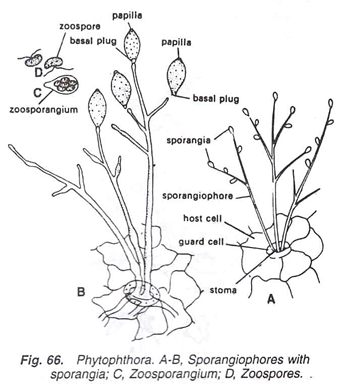In this article we will discuss about the asexual and sexual reproductive structure of phytophthora.
Asexual Reproduction of Phytophthora:
1. Asexual reproduction takes place by conidiosporangia developed on branched conidiophores or sporangiophores.
2. Sporangiophores are the branched hyphae which come out through the stomata of the host leaf.
3. At the tip of the branches of sporangiophores develop sporangia (Fig. 66).
4. Each sporangium is an oval, multinucleate structure with a short stalk.
5. A thin, hyaline papilla is present at the tip of each sporangium.
6. At first, sporangia are terminal but later on they become lateral due to the sympodial branching in sporangiophores.
7. Multinucleate protoplasm of sporangium divides into many uninucleate structures, which later on form bi- flagellate, kidney-shaped zoospores (Fig. 66C, D). These form the new mycelium on germination.
Sexual Reproduction of Phytophthora:
1. Sexual reproduction is oogamous and takes place by antheridia and oogonia. P. infestans is heterothallic.
2. Antheridium arises as a globose swelling which later on attains a funnel-shaped structure, present at the base of oogonium in the form of a collar showing amphigynous condition.
3. Oogonium (Fig. 67) is a spherical or pear-shaped structure lying above the antheridium. It contains an egg.
4. Antheridium forms a fertilization tube which enters in the oogonium through the receptive spot. Through this tube the male gamete comes in contact with the female gamete to form an oospore.
Control:
1. Spraying of fungicides.
2. Use of resistant varieties.

